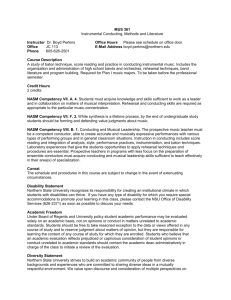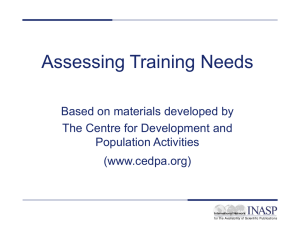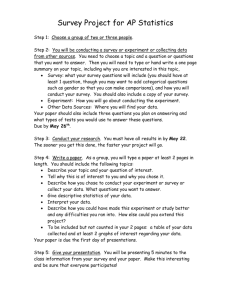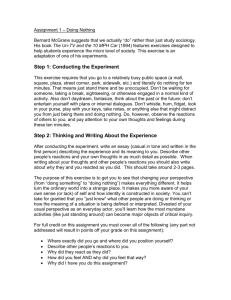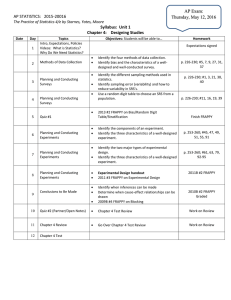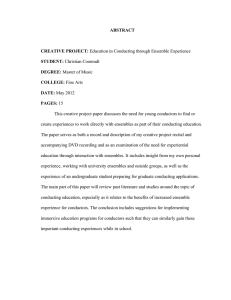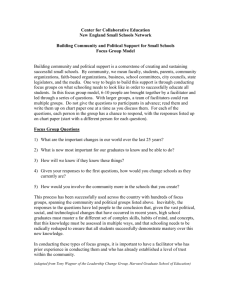MUS 286 Basic Conducting II Spring 2011
advertisement
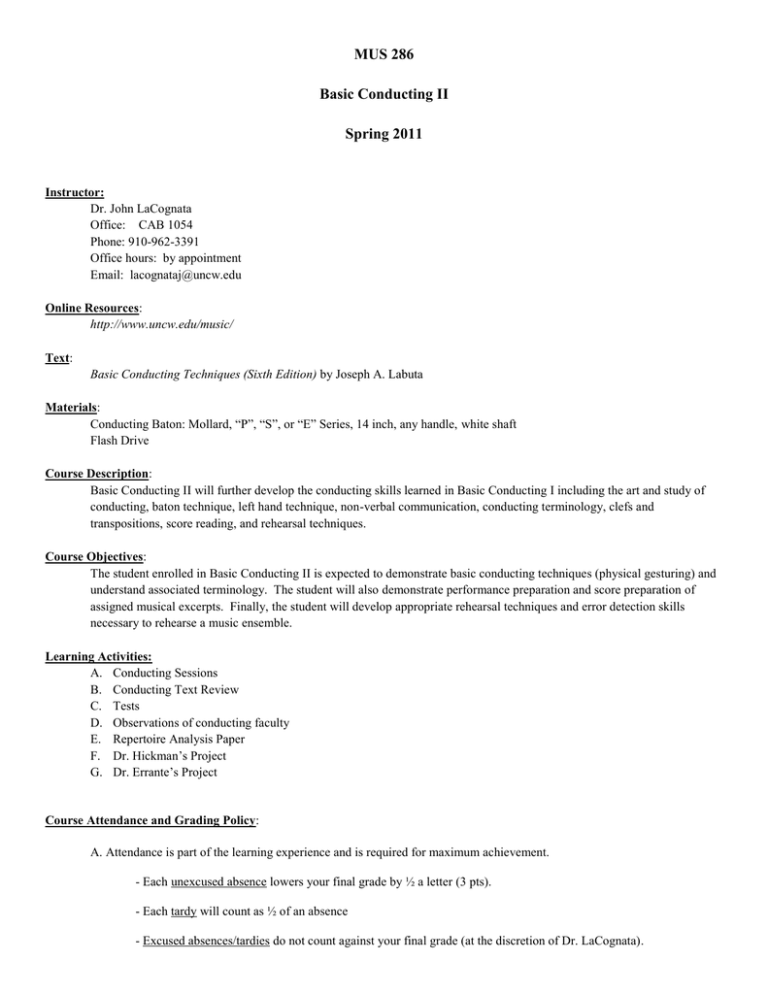
MUS 286 Basic Conducting II Spring 2011 Instructor: Dr. John LaCognata Office: CAB 1054 Phone: 910-962-3391 Office hours: by appointment Email: lacognataj@uncw.edu Online Resources: http://www.uncw.edu/music/ Text: Basic Conducting Techniques (Sixth Edition) by Joseph A. Labuta Materials: Conducting Baton: Mollard, “P”, “S”, or “E” Series, 14 inch, any handle, white shaft Flash Drive Course Description: Basic Conducting II will further develop the conducting skills learned in Basic Conducting I including the art and study of conducting, baton technique, left hand technique, non-verbal communication, conducting terminology, clefs and transpositions, score reading, and rehearsal techniques. Course Objectives: The student enrolled in Basic Conducting II is expected to demonstrate basic conducting techniques (physical gesturing) and understand associated terminology. The student will also demonstrate performance preparation and score preparation of assigned musical excerpts. Finally, the student will develop appropriate rehearsal techniques and error detection skills necessary to rehearse a music ensemble. Learning Activities: A. Conducting Sessions B. Conducting Text Review C. Tests D. Observations of conducting faculty E. Repertoire Analysis Paper F. Dr. Hickman’s Project G. Dr. Errante’s Project Course Attendance and Grading Policy: A. Attendance is part of the learning experience and is required for maximum achievement. - Each unexcused absence lowers your final grade by ½ a letter (3 pts). - Each tardy will count as ½ of an absence - Excused absences/tardies do not count against your final grade (at the discretion of Dr. LaCognata). 2 - For an absence to count as excused, you must email Dr. LaCognata before the scheduled class. Include in your email: - Your name (first and last) - Date of anticipated absence - Reason for absence - In emergency situations where email is not possible, call Dr. LaCognata at 962-3391 and leave a message. - An illness will be excused with a doctor’s/clinic’s note. B. Tests and assignments must be completed at the time they are scheduled for full consideration. Points will be deducted for work that is not timely. Grading A. Conducting sessions (30pts) Each student will be evaluated when they conduct the Petite Arpeggio by Dr. LaCognata (Wednesday). The student will obtain the video of their conducting round at the following Monday class and after review of the video turn in a written self-evaluation at the next Monday class. B. Conducting Text Review (10 pts) Each student will select and write a 5-7 page review of an instructor-approved area-specific (choral, instrumental) conducting text (Normal Margins, 12 pt Times New Roman Font, Double-spaced). The review should focus on issues and discuss the texts content, presentation, musical excerpts, features, appendixes etc.... C. Tests (20pts) Each student will demonstrate their knowledge of conducting terminology through a series of written tests. Topics will include clefs and transpositions, tempo, time, dynamics and style. D. Observations of conducting faculty (see rehearsal observations form) (8pts) E. Repertoire Analysis Paper (16pts) Each student will write a 9-11 page formal analysis of the work/excerpt they have selected to conduct on their final conducting round (Normal Margins, 12 pt Times New Roman Font, Double-spaced). The analysis will include discussions on the works composer, time period, background, conducting issues, and rehearsal issues. The paper will also include a detailed analysis on the work (i.e. form, harmonic analysis, melodic analysis). F. Dr. Hickman’s Project (8pts) G. Dr. Errante’s Project (8 pts) Grading Scale For the final course grade, a ten-point grading scale will be used as follows: 92-90=A82-80=B72-70=C62-60=D- 100-93=A 86-83=B 76-73=C 66-63=D 59-below=F 89-87=B+ 79-77=C+ 69-67=D+ 3 Course Schedule A detailed course schedule will be distributed. Academic Honor Code The University of North Carolina at Wilmington is committed to the proposition that the pursuit of truth requires the presence of honesty among all involved. It is therefore this institution's stated policy that no form of dishonesty among its faculty or students will be tolerated. Although members of the university community are encouraged to report occurrences of dishonesty, each individual is principally responsible for his or her own honesty. All students are encouraged to read section V "Academic Honor Code", in the UNCW Student Handbook, for definitions of plagiarism, bribery, and cheating, and the procedures for reporting and adjudication of any activities involving student dishonesty. Services for students with disabilities Students with diagnosed disabilities should contact the Office of Disability Services (962-7555). Please give me a copy of the letter you receive from Office of Disability Services detailing class accommodations you may need. Harassment UNCW practices a zero tolerance policy for any kind of violent or harassing behavior. If you are experiencing an emergency of this type contact the police at 911 or UNCW CARE at 962-2273. Resources for individuals concerned with a violent or harassing situation can be located at http://www.uncw.edu/wsrc/crisis.html. Caveat The above procedures, policies, and schedule for this course are subject to change. No change will occur without adequate notice and preparation. **Please turn off all cell phones and pager devices during class sessions.** 4 SELF/INSTRUCTOR EVALUATION FORM Name ____________________ Date_________ Excerpt Conducted ____________________ After viewing the video-tape of your conducting evaluate the following areas for very good elements and for those that need improvement. It is important to be fair to yourself where you excel and where you need improvement. Evaluations are due the following class period after your exam. Use the following categories and specific areas in your self evaluation. Posture – Arm/Hand Positioning (proper foot position, knees relaxed, straight spine, upper body posture, upper arm forward, elbow lifted, forearm – upper arm angle, forearm extended, proper hand position, fingers naturally curved) Preparation (mental set, group scan, smooth preparatory gesture, rhythmic breathing motion, eye contact, tempo, dynamic level, articulation, clear ictus, confident and assuring demeanor) Beat Patterns and Releases (vertical plane location, vertical plane amplitude, horizontal plane location, horizontal breadth, clear ictus on each beat, pattern clarity, internal releases, final release, release preparation, communication) Baton Grip and Use (proper contact points, natural curve of fingers, correct direction of baton, baton on vertical plane, ictus at baton tip, ictus on horizontal plane) Left Hand (at rest position: side, at rest position: front, attention position, smooth and independent, appropriate dynamics, crescendo – decrescendo, appropriate releases, sustaining gestures) Rehearsal Techniques (error detection, isolation of error, clarity of instruction, effectiveness of instruction, rehearsal flow) 5 SELF/INSTRUCTOR EVALUATION FORM p. 2 Evaluation Summary: Summarize your conducting evaluation in narrative form. Write one paragraph summarizing the positive elements of your conducing and a paragraph on those elements that need improvement. SUMMARY OF POSITIVE ELEMENTS: SUMMARY OF THOSE ELEMENTS IN NEED OF IMPROVEMENT: 6 REHEARSAL OBSERVATIONS FORM Students must attend the full length of each rehearsal and have the director of the ensemble initial this form immediately following the rehearsal. Be beyond courteous and professional. Contact the conductor of the rehearsal you wish to observe at least 1 week prior to visiting rehearsal. You are expected to visit 3 rehearsals throughout the semester. You should visit a choral, band, jazz or orchestra/string rehearsal. Please refer to the course schedule to see when evaluations are due throughout the semester. Do not forget to have them sign your form at the conclusion of the rehearsal! Discuss your observations of rehearsal flow and pace, warm-ups, tuning, and demonstration in your two (2)-page review of rehearsal. Take notes during rehearsal so you have something to reference when writing your review. 1. Date of Observation: ___________________ Name of Ensemble:___________________ Director: Director’s Signature: _________________ 2. Date of Observation: ___________________ Name of Ensemble:___________________ Director: Director’s Signature: _________________ 3. Date of Observation: ___________________ Name of Ensemble:___________________ Director: Director’s Signature: _________________

